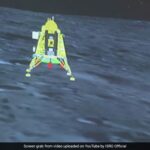India’s space economy is expected to be worth USD$13 billion by 2025.
On Wednesday, the Chandrayaan-3 spacecraft landed on the Moon – an event with the potential to unlock real economic benefits.
Chandrayaan-3 is the third lunar exploration mission by the Indian Space Research Organisation. India became the fourth country after the United States, the former Soviet Union (now Russia), and China to achieve a soft landing on the lunar surface.
Crash landings – like what happened with Chandrayaan-2 – don’t count.
After Chandrayaan-3 landed, the rover Pragyan rolled out of the lander Vikram to roam around the lunar surface collecting data.
The success of the mission, not only helped India make great strides in the space race but could also prove to be a big boost to the country’s economy.
The world has already seen everyday benefits from previous space efforts like accessibility to clean drinking water with water recycling on the International Space Station, near-global internet access provided by Starlink for education, advances in solar power generation and health technologies.
With an increasing demand for global data of satellite imaging, positioning and navigation, multiple reports indicate the world is already in an exponential growth phase of the space economy. A report by Deloitte highlights how since 2013, over USD$272 billion has been raised by private equity into 1,791 companies.
In their annual report, the Space Foundation noted the global space economy has already reached a value of USD$546 billion in the second quarter of 2023. This represents a 91 percent increase in value over the past decade.
For many countries, participating in the nascent space economy has the potential to have huge downstream benefits for their own economies, as well as inspiring their citizens to engage in the new space age.
Although NASA did successfully put humans on the Moon during the Apollo Program more than 50 years ago, many seem to have forgotten the incremental steps and huge amounts of money it took to get there.
There were also many unknowns, including real worries that the lunar surface was so soft and dusty due to billions of years of meteorite bombardments that spacecraft would sink into the surface like quicksand – a concern that luckily proved unfounded.
But even with 21st century advanced computing and cutting-edge technology, the difficulties of spaceflight remain the same – can your system maintain stable communications and operate autonomously under a wide variety of extreme conditions?
With inputs from NDTV




 Leaders across party lines hail ISRO for Chandrayaan success
Leaders across party lines hail ISRO for Chandrayaan success 